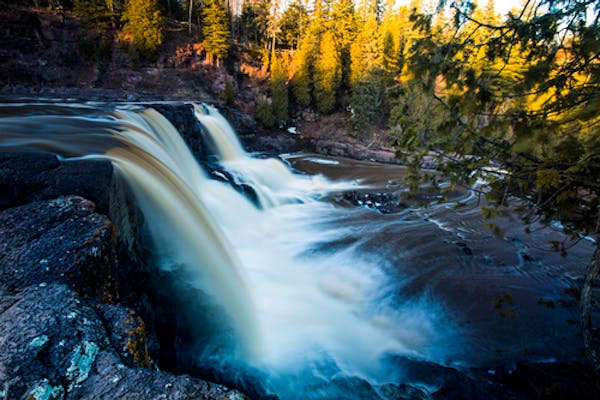The time has come for stewards of the Superior Hiking Trail to address the needs of one of the most visited and photographed parts of the 310-plus-mile trail.
Work begins Wednesday to finish a reroute of the trail that began in 2019 near the commanding overlook of Bean and Bear lakes near Silver Bay — sites that in some circles are synonymous with hiking on the North Shore. Instagram feeds in autumn can attest.
"This is a big project," said Barbara Budd, volunteer and education coordinator with the Superior Hiking Trail Association (SHTA) in Two Harbors.
And it matters when getting on the Superior trail — or any trail — is seen by so many Minnesotans and countless others as essential infrastructure for recreation, from camping to running to bird-watching, and so on.
The Bean and Bear reroute is so significant that the SHTA is asking for the public to get its hands dirty and help. Directed by Trail Eyes LLC, a trail-builder and consultant, and association staff, volunteers will dig out vegetation, cut brush and build retaining walls to direct the footpath away from a chronically wet, muddy area through higher, more sustainable territory in the Penn Creek area. There are about 100 work shifts that still need filling out of 200 over the 11-day project, Budd said.
In tackling the reroute, the SHTA is moving on with work it identified in 2017 as part of its broad trail renewal plan, said executive director Lisa Luokkala.
There are at least a dozen other projects of various sizes planned this hiking season, too, from engineering better ways to keep the trail dry in notoriously wet areas to bridge-building, to replacing old, heavily trampled boardwalks.
"The trail really is never complete," said Luokkala, recognizing the impact of the predictable (use, erosion) and unpredictable (intense weather seasons).
One notable project is the second phase of a well-known thorn among trail staff, volunteers, and hikers: the "Gooseberry Gap," which reflects the private-public land balance that energizes the path and is top of mind at the association. A conflict with a private landowner forced the trail off a parcel and required the gap workaround in 2015.
Work has begun on 2.7 miles of new trail to close a gap between Gooseberry Falls State Park and Blueberry Hill Road. Hikers currently detour to roads and the paved Gitchi-Gami State Trail. Using a $60,000 matching grant from the Iron Range Resources and Rehabilitation Board, the association began the work in 2021. The reroute is entirely on state and Lake County land.
Luokkala said the popularity of Bean and Bear lakes reflects what is happening at many other iconic spots along Lake Superior, where photographic moments of land and water pop up at every turn.
She said many are easy to access through a day hike or other manageable means, and the result, like at Bean and Bear, is repeated heavy use.
"The concept of managing visitors up and down the Shore … we have to be more cognizant," she said. That might mean trip-planning advice from staff that recommends visiting popular spots on weekdays, giving the trail "a little time to heal," she added.
Welcoming community
This year the SHTA will spend about $600,000 on tools, materials, permits, trail subcontractors, and related expenses, but all along the path, the main resource remains human.
"The trail still is very much volunteer-powered," said Luokkala. "We get these grants to get contractors and professional folks. Still, at the end of the day, the annual maintenance is happening by volunteers. It is really quite unique and needed."
Last year, 300 volunteers gave 6,500 hours (or 271 days) to various projects and yearly commitments like the association's trail section and campsite adoption programs.
Luokkala and Budd know longtime volunteers will continue to put in the hours, but they encourage others to make the leap to take a shift, whether it's for a few hours or a few days. Near Bean and Bear lakes, the SHTA has a designated campsite for volunteers who want to stay near the work site, a 3-mile hike from the trailhead in Silver Bay. The SHTA is also providing dinner for volunteers — a touch that speaks to the trail community. The terrain, the people, the service — all can be infectious.
"It really is a community," Luokkala said. "You meet cool people and are exposed to fun, quirky, dedicated, outdoorsy people who have trail stories and unique connections.
"There are so many opportunities. You are not limited to [Bean & Bear]. Just come. It is the most welcoming, friendly people you could possibly meet."
Budd worked for the Forest Service and the Washington (State) Trails Association before joining the SHTA. Several months into her new role, she said volunteer pride and ability in taking care of the Superior Hiking Trail are unmistakable — and motivating. She wants the same for newcomers this season.
"Once you have been out and worked on a trail," she said, "you will never look at it the same again."
To register and learn more about volunteer work on the Bean and Bear reroute June 15-26, and other projects, go to superiorhiking.org/volunteer/.
Live: Wolves vs. Suns in Game 1 at Target Center. Follow on Gameview.
Biden's new Title IX rules protect LGBTQ+ students, but avoid addressing transgender athletes
Federal officials are investigating a Rockies coach's cockpit visit during a United flight
Buffalo Bills owner Terry Pegula explores selling non-controlling, minority stake in franchise

